"Failure is simply the opportunity to begin again, this time more intelligently."
-Henry Ford
Back in 2003, a twin pair of rovers -- Spirit and Opportunity -- were launched from Earth to Mars. For no good reason at all, Opportunity has long been my favorite of the two.
Opportunity landed in January of 2004 in Eagle Crater, a relatively small crater on the surface of Mars. Originally slated for a 90-day mission, Opportunity has been going strong for nearly seven years now!
Over that time, it's made some amazing discoveries, including the following:

Discovering -- up close -- what look like dried-up tracks from flowing water at Burns Cliff.

Discovering "martian blueberries," or hematite spheres about half the size of your little finger's nail. These are particularly interesting, because these litter nearly the entire path of Opportunity along the Meridiani Planum, and are formed on Earth in hot springs and pools of standing water.
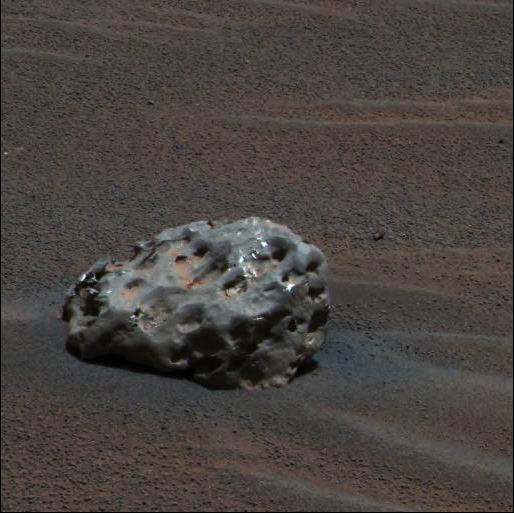
Discovering "heat shield rock," the first meteorite ever found on another planet!
And, of course, there were many others. By time more than two-and-a-half years had gone by, Opportunity had taken a remarkable journey across the martian plains, passing all these sights and then some, making it all the way to Victoria Crater.

The rover spent nearly two years exploring the crater's rim and interior, creating a topographic map of the interior and studying the layering along the crater walls.
(Go ahead and click on the image below for an amazing panorama of Victoria crater taken by Opportunity!)

After nearly five years and 20 kilometers (a record!) traveled, Opportunity was told to travel across the plains, once again, to Endeavor crater, which would mark the largest crater ever visited by a rover.
Below, compare Endeavor to Victoria -- just above center -- to get a sense of scale.
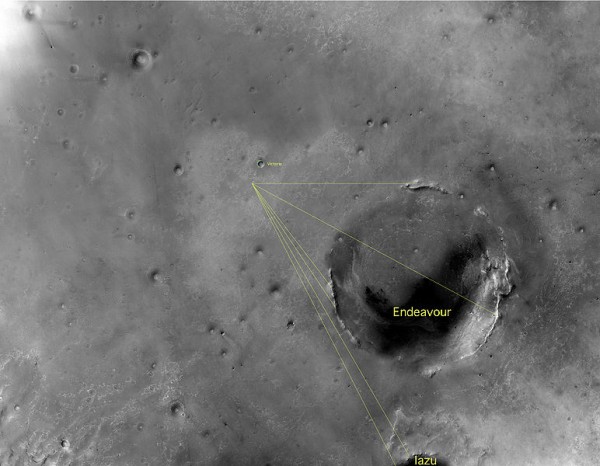
By this time, though, Opportunity's time on Mars had taken its toll. Its solar panels -- the source of its power -- had been obscured my martian dust. In fact, by April of 2009, Opportunity was only receiving 50% of the power it had been receiving in January of 2004, thanks to the huge amount of (easily visible) dust clogging its panels.

With an additional 12 kilometers to travel to Endeavor crater, Opportunity would need a lot of luck to get there.
And then it happened. A huge gust of wind came along, knocking a large amount of dust off and giving Opportunity a 40% power boost.
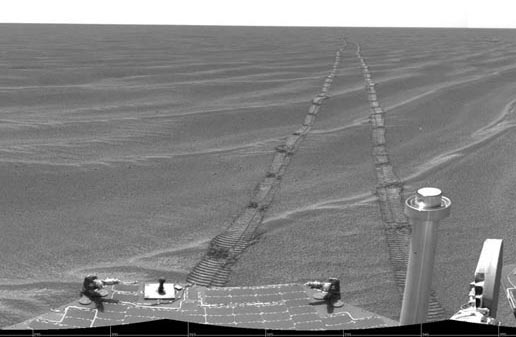
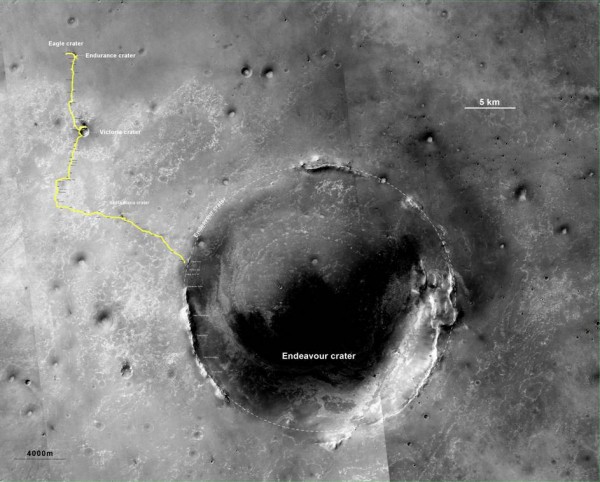
It's there now. Just a few days ago, Opportunity -- the one surviving twin -- arrived at the rim of Endeavor crater.

And what you're about to see are its very first photographs of the largest crater on another world to be visited by a man-made rover.
(All subsequent images credit: NASA/JPL-Caltech/Cornell/ASU, annotations courtesy of Ken Kremer. As always, click for a hi-res version.)
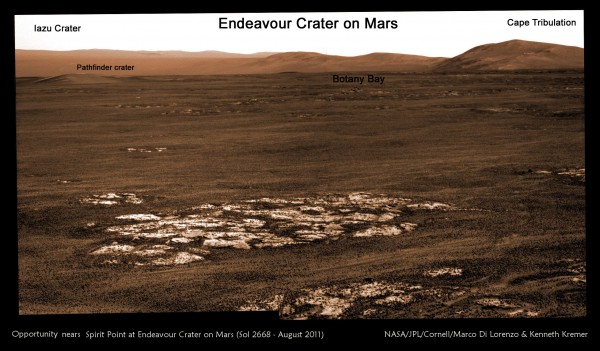

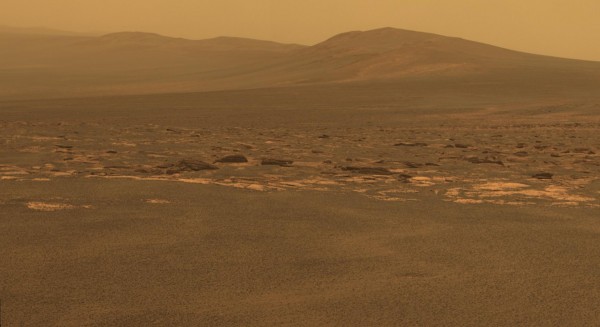
The astute among you who click on this final image to get the hi-res version will notice a graininess on the ground. Those are still martian blueberries, or hematite spheres, suggesting this entire journey that Opportunity's taken has been along ground that was once underwater!
And now that it's at the crater's rim, the next step is going to be to explore this 22-kilometer-wide behemoth. It arrived at the crater rim just yesterday, at the outcrops named "Spirit Point" after its deceased twin.
Inside the crater will be the oldest geological layers ever accessed on Mars by any scientific instrument. Opportunity has officially run for nearly 30 times its expected mission duration, and it's still going strong. I know everyone with a sense of curiosity is with me right now, thinking that you can't wait to see what Opportunity finds next!

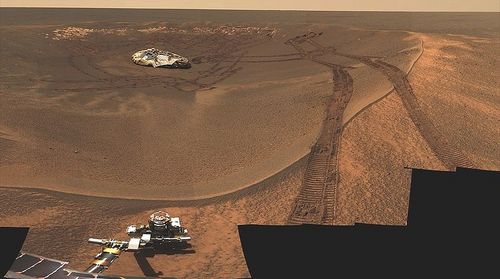
You know those "Foundation for a Better Life" billboards? The "pass it on" ones?
Those rovers ought to be nominated for the first nonhuman examples, category "overachievement" or "quality."
I'm 58 years old. I still get excited. I feel like I did when I read the "Lucky Starr" books 50 years ago. When is the next blast-off from Florida?
Thanks for this post. I have long been in awe of both rovers. One would be hard-pressed to find a person on this planet that would have predicted that either rover would still be operational in 2011. The images of Endeavour Crater are terrific!
I've always been a bit partial to Spirit, though. I've always been a sucker for the underdog. Or underrover, as it were.
Mars rovers are my favoritest robots :-)
I always smile a bit when it is related that they were "Originally slated for a 90-day mission". I've always assumed that was the shortest warranty JPL thought they could get away with when selling to the bureaucrats with the purse strings.
Amazing engineering.
YAY OPPORTUNITY
Man, whenever I hear people complaining about no more shuttle flights, I never understand it. The Mars rovers are so much cheaper and so much more awesome. What we need from NASA isn't a bunch of low-earth-orbit space tourism, what we need is a crapload of more stuff like this. How thrilling it is that we can extend humanity's sight so much further than our little human eyes can take us.
xkcd has a comic about the rovers
http://xkcd.com/695/
(although it's Spirit)
Ok, what gives? I admit I haven't been paying close attention recently, but I have had an image of cliffs from "endurance" crater as my desktop background since 2004, and now these reports that Opportunity has just arrived at endurance crater:
http://marsrovers.jpl.nasa.gov/gallery/press/opportunity/20040506a.html
Did they leave the crater and then return? Have they changed the name of my crater? Help appreciated.
Endevour, Cape Tribulation, Cape York.....Ahh, think it's time to book a holiday in the tropics again....Haven't been to Cape Trib. in 6 years, but regularly go to Cairns.
Whoops, my bad! I was confusing "endurance" and "endeavour".
I would love to meet the teams that designed and operated the Rovers, what an unbelievable job they have done. We have seen the future of space exploration. I am sure though the designers must be regretting not building in a cleaning mechanism for the solar panels.
Those photos of the surface of Mars give one a remarkable sense of immediacy. Mars is not just a pinpoint of light but something real, accessible and something like us. But the lonely barrenness of the Martian plains is frightening, it is the first time we have examined close up a world entirely without us. It is humbling and awful. I have started looking again through my "Rare Earth" book by Brownlee and Ward and re-reading the Fermi Paradox. Is it possible we are really alone in this universe? Our psyche demands a universe filled with life. If we are really alone we must reconcile ourselves to an unbearable loneliness in a vast universe. And then we must accept the unbearable responsibility of safeguarding the one flicker of beautiful life in that universe.
psmith: The rovers' designers did, from what I can recollect, play around with some designs for a solar panel cleaner. But they were running into problems coming up with designs that were mechanically simple and didn't add too much mass to the rovers. Eventually, they just decided to rely on the martian wind and hope for the best - a strategy that paid off, overall.
D. C. Sessions #1: Those rovers ought to be nominated for the first nonhuman examples, category "overachievement" or "quality."
This may sound like nitpicking, but no. In engineering terms, quality = predictability. You design for a target, not over it. Anything that goes over the target is waste of resources.
In space exploration you can't define the target, and getting there takes more resources than whatever is done there. So quality doesn't count that much. You go for robustness.
I still get as excited over this as back when Neil Armstrong mis-spoke his famous quote, back when I was eight. (I didn't know then that he meant to say, "that's one small step for a man".)
I have to wonder when a man will walk up to Opportunity, pat it on its camera, and tell it, "Well done, and thanks!" When I was eight, we were supposed to be on Mars by now.
D.C. Sessions,
There may not be much savings in designing for a season in the hostile and poorly understood martian environment, and not surviving the martian winter. But in politics there is good reason to set the expectations low, so they can be exceeded and to reduce the risk of failure. I bet they designed those rovers the best the could with the funds available, with the idea that if they extended their lifetimes, the funding would come. It wasn't all good design, it took a lot of ingenuity to get keep those rovers running and to get them out of various predicaments.
The folks at JPL are also very good at getting the most out of a spacecraft. Consider the Voyager Interstellar Mission: the original Voyager 1 mission to Jupiter and Saturn ended in 1980, and Voyager 2's study of all four giant planets ran through 1989. JPL is getting data from Voyager at 160 bits/second, which doesn't sound like much nowadays, but they're still getting data.
It's impressive scenery and an impressive technological achievement. But don't you also find it a little depressing to see inhospitable wilderness stretching out to every horizon? And it's not just that the rover landed in a desert-like region. The whole planet is like that!
I love that they named some features after Alvin, Jason and Argo - some machines* we need more examples of on Earth and in space.
*Yes, yes, they may have been named after much older inspirations than submersibles, but that's what I think of when I hear those names.
I can't think of these two without envisioning Wall-E and getting a little misty-eyed.
An undeniably impressive technological feat! But, those "blueberries" that rolled out from their ancient sediment host may have formed as concretions in the presence of water but the hematite is certainly post=depositional, a result of the later dehydration of the original water-precipitated iron minerals, the hydrous ferric oxides. And, if the blueberry hematite is really the gray, coarse-grained, platy variety "seen" from space (and which heavily influenced the Rover site selection), it is more than just diagenetic, it is metamorphic. Strongly heated. Either way, the water in which they formed was long gone from these rocks that are billions of years old. Very small chance of finding life in billion-year old rocks, even on Earth. Our billion-year old Archean banded iron ores contain huge amounts of hematite, even coarse-grained platy hematite, but no water...and very few fossils.
Next visit to Mars, following the water, looking for life? This time follow your Henry Ford quote: "more intelligently" Look for other minerals such as aluminosilicate clays or the hydrous iron oxides,but not hematite. Clay minerals, at least, still have water in their structure. Hematite does not.
Fantastic!! I absolutely LOVE the high res pics that you get for your posts, Ethan. That panorama is getting printing out and going up on my wall.
I wasn't around for the moon landing, that was well before I was born, but I think I would just cry my heart out to see someone, as mentioned, eventually reach Opportunity, and give it a good old "Well done,". It's well deserved.
I don't see the inhospitable desert of mars as depressing. I see it as exciting!! This is an ENTIRE OTHER PLANET for us to explore! If we can eventually get there that is. Sure it just LOOKS like a dry drab desert, but who knows what amazing wonders it has hidden for us to find!
I designed the oscillators. :) Nice to meetcha.
wonderful!! Innumerable Thanks for sharing.
FWIW, I am an engineer -- and when we shoot for a design life of 90 days, we're stacking a whole buncha sigmas to make sure that a failure at 90 days is pretty danged unlikely.
Take those sigmas the other direction, or even just stick around peak probability, and you're out quite a ways.
What that analysis does not account for is design defects. In any complex effort that can't be completely tested in advance, there are innumerable ways to shoot yourself in the foot. Many aim higher, e.g. the nads.
So: I stand by my assertion that the rovers demonstrated excellent design quality. First, by avoiding optimism of the Challenger strain. Secondly, by avoiding fatal design failures.
I'm not overly excited about the Rovers.
But let me add my 1 cent.
Opportunity and Spirit were worth every penny.
For what??
A million photographs and a million pages of meteorological and geological data?? Yes!!
The technological spin-off? Yes!!
And this is enough; but I think there is much more. What much more?
The Rovers do gritty science in every sense of the word. Travelling 20 miles in 7 years measuring temperature, pressure, wind, snapping pictures up at that landscape and down at these pebbles and around and around... well it's so boring...
But it's more than these little machines; its thousands of man and women's scientific and technical minds focused persistently upon these two microscopes placed upon our fellow planet, Mars. Yes Rovers are microscopes. My eyeballs and brain hurts just thinking of focusing upon such microscopic almost insanely same detail. Why? Why?
Well yes a lot of good science is boring; how many paramecium can one man look at?
But no one seems to mention scientific spin-off. Yet, it seems to me that the greatest value to humanity of Opportunity and Spirit's millions of photographs and millions of pages of data is the scientific spin-off. What???
What science spin-off? The science of how a planet works meteorologically. We had all of the boring data for Earth; now we have the boring data for Mars too.
And guess what? Some of the meteorological models broke when scientists put Mars' temperatures, winds, solar radiation and other data into their models. So planetary weather models got a whole lot better; because of Opportunity and Endeavor.
Now I live here on planet Earth and thus have a vested interest in having planetary weather model that works well. When the global warming scientist run their weather models; I want to know that their models worked not only for cozy 20th century Earth; I want their models to works even for extreme planetary weather such as Mars!!
So, I'm very glad Opportunity and Spirit didn't get buried in a Martian sandstorm. Because now our Earth weather models that predict global warming are better and more robust, maybe much better models; because of Opportunity and Spirit.
So that's just my 1 cent. Just a hypothesis.
Anyway, thank you very much Rover scientists and engineers and technicians. Don't mind my eyeballs, they are just hurting thinking about your work; which I really really appreciate. Next Mars Rover is planed to launch in November 2011. Nice.
Such hard hard work. Yes, I guess we do need to personalize these little Rovers as heroes. It's shorthand for looking thousands of people in the eye and saying, "Thank you, thank you. Job well done!"
Re: OKThen
The best model is the one that makes accurate predictions for your modeled responses over the range you're interested in. Trying to make a model cover a wide range of responses than is necessary will almost always result in a worse model, not a better one.
One spin off from the rover missions you may not have heard about.
Remember the air bag balloons that they inflated around the rovers to "bounce" them to a safe landing. This involved the invention of a new form of textile that was a strong as steel.
The inventor of that fabric from those missions went on to create what I consider to be the most amazing technology coming out today - the XP car!
This is an inflatable car that uses air as the body, uses a fraction of the materials of a regular car, is hugely safer (you are surrounded by an air bag), packs very small for easy transport to global markets, and most importantly can run 2000 km on a regular electric car battery or fuel cell.
The government was going to help them develop it but then during the GFC slushed out all the cash instead to GM for the Chevy Volt! Because of the credit crunch they are having trouble financing. This is the kind of technology that made America a superpower. I'd encourage anyone looking to invest in something that is game changing to check out their website.
http://www.myxpcar.com/
Rev Enki
Good point.
Sam Nelson
Very nice. I did not know.
90 days was a very "Scotty" estimate.
The next rover mission, Mars Science Laboratory, is due to launch by the end of this year, 2011.
The scary, scary, scary part is the landing sequence. An awful lot of things have to go exactly right, and it's a year of transit in harsh space to travel to Mars, plenty of time for all kinds of deterioation, or parts seizing up.
For example, the British Beagle 2 didn't make it. Gut wrenching stuff.
Only if the heavens above can be measured and the foundations of the earth below be searched out will I reject all the descendants of Israel.